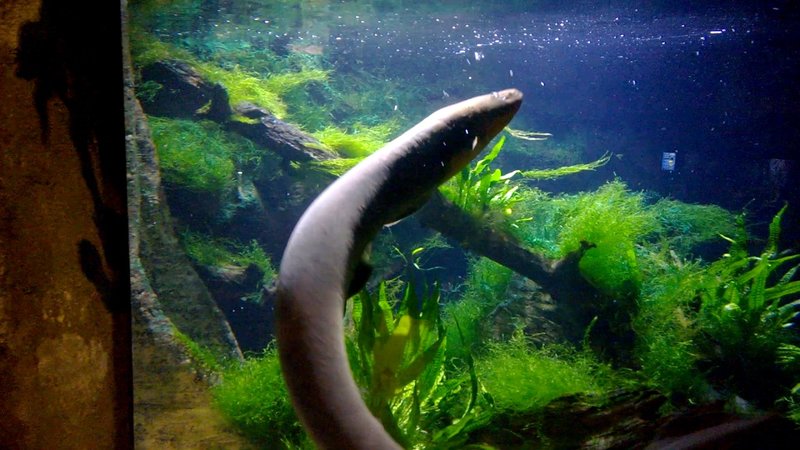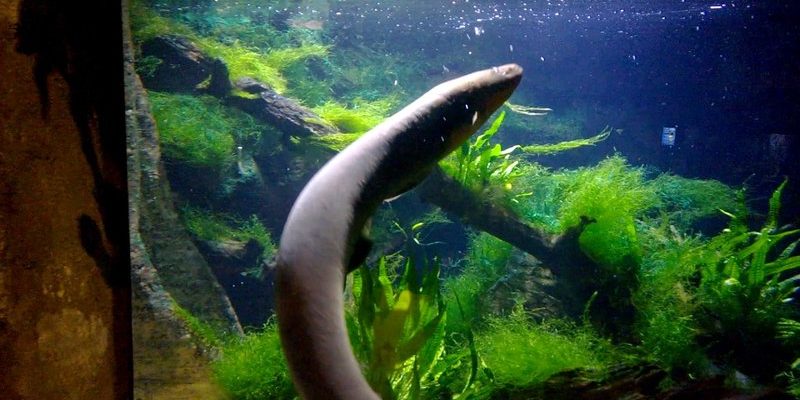
Electric eels can grow quite large, reaching lengths of up to 8 feet (about 2.5 meters). As fascinating as they are, they’re not just odd-looking; they’re skilled predators who have adapted to thrive in their environments. You might be wondering how they catch their meals, especially in dark waters where visibility is low. That’s where their impressive electric shock comes in handy — it’s like having a built-in flashlight and stun gun!
Understanding the Electric Eel’s Diet
The diet of the electric eel is as interesting as its hunting techniques. These creatures are carnivorous, meaning they primarily eat other animals. Their menu mostly consists of:
- Fish
- Frogs
- Crustaceans
- Small mammals
Electric eels are opportunistic hunters. They don’t just wait for their food to swim by; they actively seek it out. Their diet may change based on what’s available in their environment. For example, if fish are scarce, they might turn to frogs or even small mammals that venture too close to the water.
You might be surprised to learn that electric eels can eat large prey relative to their size. This ability allows them to take full advantage of whatever food sources are available, helping them thrive in diverse situations.
How Electric Eels Hunt
Hunting for food in dark waters can be tricky, but electric eels have a unique way of finding their next meal. They primarily use two hunting techniques: electrolocation and stunning their prey with electric shocks.
Electrolocation is like sonar for fish. Electric eels emit low-voltage pulses of electricity into the water. When these pulses hit an object, like a fish, they bounce back. The eel can sense these returned signals and pinpoint the exact location of the prey. It’s an impressive skill that allows them to detect movements even when the water is murky or they’re hiding in vegetation.
Once the eel identifies its target, it can deliver a powerful electric shock — up to 600 volts! This shock serves two purposes: it stuns or immobilizes the prey, making it easier to catch, and it can deter potential threats. You wouldn’t want to mess with an electric eel, and neither would fish in the area!
Feeding Strategies and Adaptations
Electric eels have developed several fascinating adaptations that help them maximize their chances of catching food. Here are a few key strategies:
1. Ambush Hunting: Electric eels often use stealth to their advantage. They might hide among plants or debris, waiting for unsuspecting prey to swim too close. Once the opportunity arises, they strike with their electric shock.
2. Group Hunting: Sometimes, these eels will hunt in groups, coordinating their shocks to take down larger prey. Working together, they can overwhelm even sizeable fish, making it easier to secure a meal.
3. Hunting at Night: Being nocturnal, electric eels are most active during the night when their prey is also on the move. This gives them an advantage, as they are well adapted to hunting in low-light conditions where their electrolocation abilities truly shine.
These strategies highlight their versatility as predators and their ability to thrive in various environments.
The Role of Temperature and Environment
The electric eel’s feeding habits can also be influenced by the temperature and conditions of its habitat. These fish prefer warm waters, generally thriving in temperatures between 75°F and 86°F (24°C to 30°C). Warmer water supports a higher metabolism, which can increase their need for food.
In colder waters, their metabolism slows down, and their feeding frequency decreases. This is important because electric eels don’t have a steady food supply year-round; they must adapt their hunting strategies based on seasonal changes and water temperatures.
Additionally, the murky waters of the Amazon River can be challenging. However, the eel’s exceptional adaptation to low visibility environments makes it a master hunter. The combination of electric shocks and electrolocation enables them to find and catch food, even in less-than-ideal conditions.
The Impact of Diet on Electric Eel Health
Just like us, electric eels need a balanced diet to stay healthy. Their diet impacts their growth, reproductive success, and overall vitality. Here are a few key points on how their feeding habits contribute to their health:
– Nutrient Diversity: Consuming a variety of prey ensures they get essential nutrients. A balanced diet helps maintain their energy levels and supports their unique physiological abilities, including electricity production.
– Reproduction: A well-fed electric eel is a better candidate for reproduction. Healthy eels are more likely to have successful spawning, which is vital for the species’ continuation.
– Stress and Survival: Electric eels that can hunt effectively are less stressed and more likely to survive in the wild. Food scarcity can lead to poor health, decreased reproductive success, and even mortality.
In essence, a rich and varied diet is crucial for electric eels, impacting not only their immediate survival but also their long-term health and reproduction.
Conservation and Human Impact
Human activities are affecting electric eels and their feeding habits. Deforestation, pollution, and overfishing can disrupt their habitats and the ecosystems they rely on for food. Here’s a closer look at these concerns:
– Habitat Loss: As rivers are modified or destroyed for agriculture and urban development, electric eels face challenges finding suitable environments. This can lead to a decrease in prey availability, impacting their diet and health.
– Pollution: Contaminated waters can harm the fish population that electric eels depend on for food. Polluted habitats threaten the entire ecosystem, making it harder for eels to find healthy meals.
– Overfishing: Overfishing affects the population of potential prey species. If the fish population declines, eels may struggle to find enough food, leading to increased competition and stress.
Conservation efforts are essential to protect their habitats and ensure their continued survival. Supporting river conservation initiatives can help balance human needs with the health of aquatic ecosystems.
The diet and feeding habits of the electric eel are a window into the life of one of nature’s most intriguing creatures. From their impressive hunting techniques to their adaptability in various environments, these eels truly embody the survival of the fittest. Their ability to generate electricity not only makes them fascinating but also plays a crucial role in how they hunt and thrive.
As we learn more about electric eels and their diets, it’s important to consider their place in the ecosystem and the challenges they face. By understanding their feeding habits and the impact of human activities, we can appreciate these incredible animals even more. When it comes down to it, the electric eel is much more than just a shocking fish; it’s a vital part of its river environment, deserving our respect and protection.

